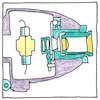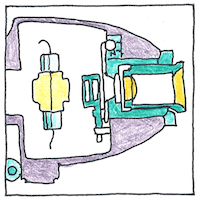Ferdinand Kurlbaum,
Ludwig Holborn,
Harmon Northrup Morse
thermometry

|
Disappearing-filament pyrometer
A hot filament at the focal plane of the objective lens of a Keplerian telescope, given a line of sight to a glowing hot object, was the first device that could measure temperatures over 1000°C. According to the rule that two objects at the same temperature emit the same black-body spectrum, the filament and the object have the same temperature when, focused on the hot object, and adjusting the current that heats the filament, the filament seems to disappear.
Ideal emissivity
An ideal black body emits the same energy at the same frequency as any other ideal black body in thermal equilibrium at the same temperature. Other than that, everything’s an imperfect black body, emitting radiation all the time, unless it’s as cold as absolute zero. You just can’t necessarily see its radiation.
Disappearing act
Alone in a darkened room, as in a box that reflects no light, you might see the heat rising from an extinguished candle, or a light-show moving slowly when you shut your eyes tightly. Although the room has disappeared, other senses tell you you remain in its space. When they left him alone in a sound-proof room, John Cage was alarmed by the rushing of his blood. There’s no reason to panic; nothing is gone except the light. Reason alone tells you the rabbit is back in the hat.



The disappearing-filament pyrometer is great for measuring the temperatures of objects that are so hot they glow, but it was not the first to determine temperatures at a distance. That honor goes to Langley’s bolometer.
See also in The book of science:
Readings in wikipedia:
Other readings: